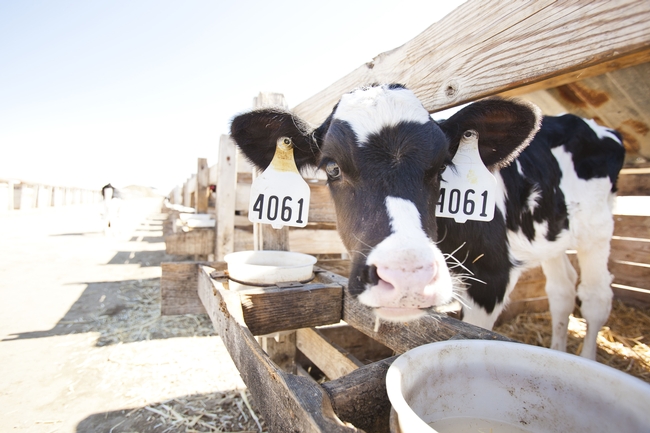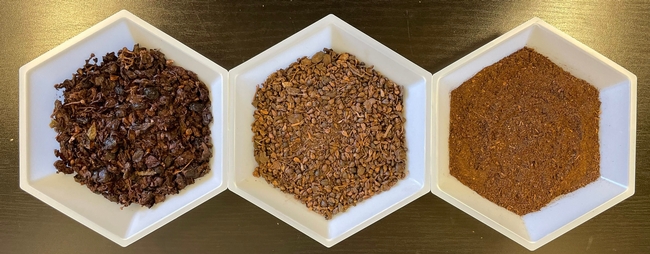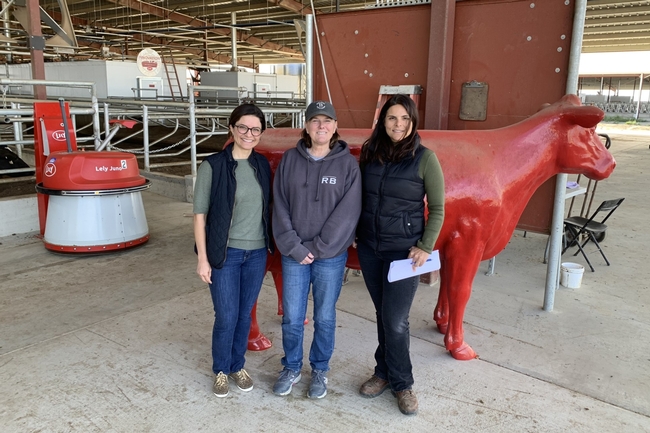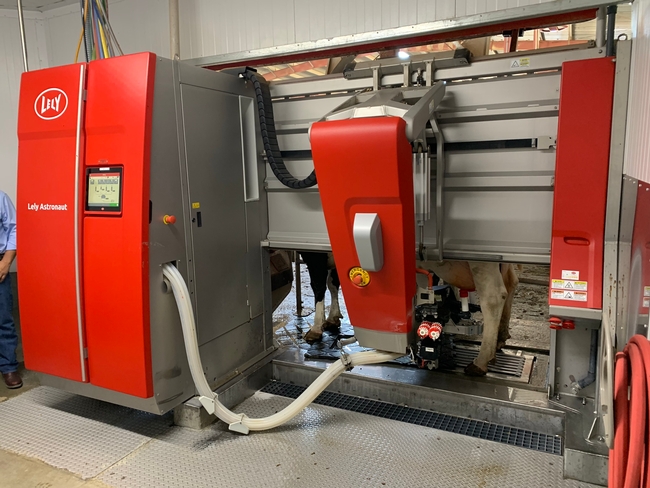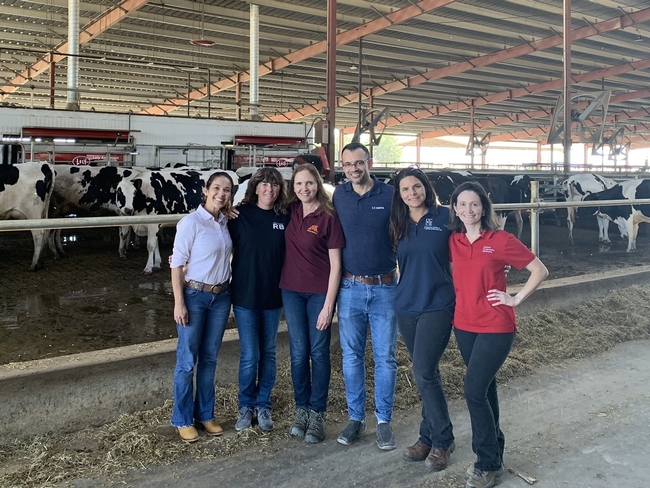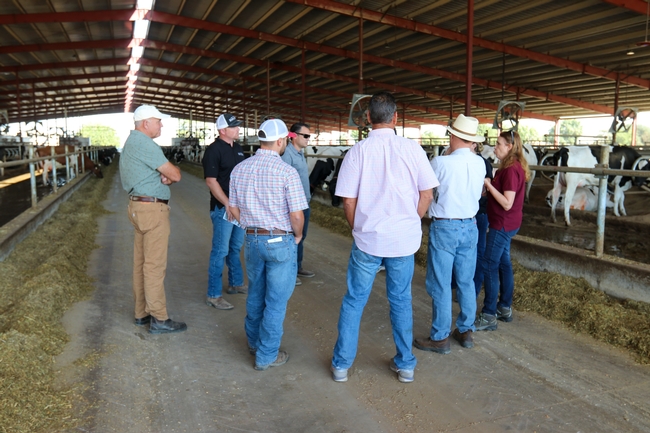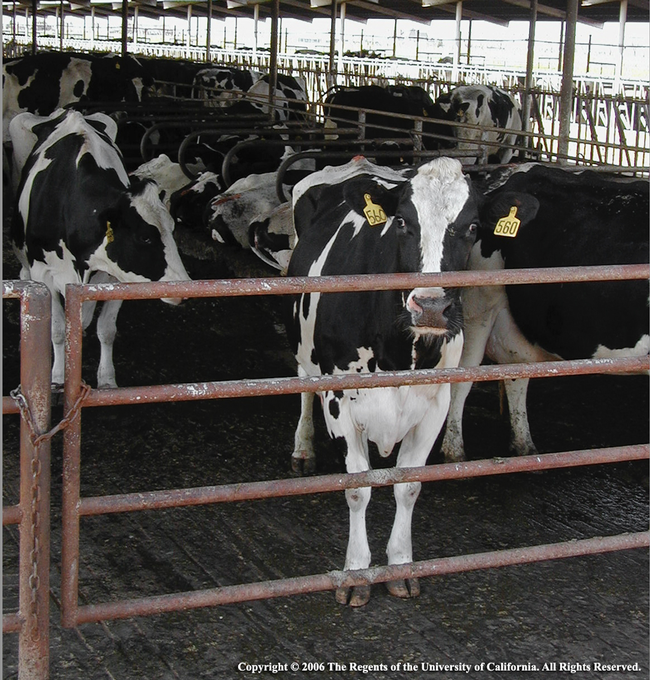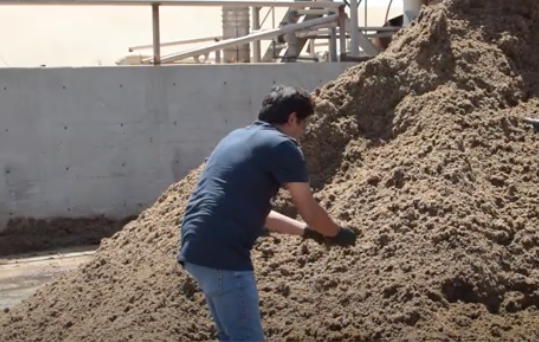Posts Tagged: cows
Grape seeds, stems and skins can reduce dairy cattle emissions
Low-cost wine industry additive also improved feed efficiency and milk quality
Researchers at University of California, Davis, added fresh grape pomace left over from winemaking operations to alfalfa-based feed for dairy cows and found that methane emissions were reduced by 10% to 11%.
The preliminary findings could offer a low-cost sustainable pathway for vineyards to reduce waste while helping dairy operations maintain quality while cutting back on emissions of methane, which is a powerful greenhouse gas.
“This is the first time anybody has shown that this can work in California,” said Ermias Kebreab, an animal science professor and associate dean of global engagement at UC Davis. “You're reducing emissions, you're improving the quality and it may also reduce the cost of production.”
The pilot research project, which will be detailed in a paper later this year, also found that mixing in grape pomace improved feed efficiency and increased healthful fats, said Selina Wang, an associate professor of Cooperative Extension in small scale fruit and vegetable processing.
“We found that the feed with the additive of grape pomace changed the fatty acid composition of the milk and, in particular, increased the polyunsaturated fats, which are the main fats in grape pomace,” Wang said. “This suggests that supplementing the feed with an optimal fatty acid profile may have positive impact on the fatty acid profile of the milk and increase their health benefits.”
Symbiotic commodities?
In 2022, California was the leading dairy producer in the country, generating $10.40 billion in sales, while 90% of wine production came from the Golden State, with a market value of $5.54 billion.
Processing grapes for wine generates thousands of tons of waste in the form of grape pomace, which consists of leftover seeds, skins and stems. Dairy and livestock are responsible for more than half of the state's methane emissions, owed largely to cow burps.
They are the top two agricultural commodities in California, according to state production statistics, and reducing waste and emissions for both industries are key to the state meeting its climate goals.
Tannins for emission reductions
Wine grapes are high in fats and tannin, which is known to reduce methane emissions, so Kebreab sought to test if adding grape pomace to feed could have a positive effect while not adversely affecting production.
“It's a byproduct that's not being used much,” he said. “This is something that can be included in our efforts to try to reduce emissions.”
A mix of feed options
To do the research, scientists worked with Holstein dairy cows and gave the animals feed consisting of alfalfa, wheat, almond hulls, cottonseed and grain. After two weeks, the cows were split into three groups: A control group with no change in diet, another where the feed combination included 10% grape pomace and a third that received 15% grape pomace.
Every four weeks, the cow groups would change feed combinations.
They were fed twice daily by postdoctoral students and interns, and emissions were monitored daily. Milk production was documented in the morning and evening and milk samples were collected weekly to analyze for fat, protein, lactose and other measurements, which showed no differences between the control and other groups.
Methane and hydrogen emissions were reduced compared with the control group, suggesting that grape pomace reduced enteric emissions without affecting production.
“I think the dairy industry will be very interested in this,” Kebreab said. “Sometimes when you're using additives, they have palatability issues. With grape pomace, they absolutely love it.”
Next on the list is a trial with olive pomace and working to understand the mechanism that reduces emissions. “If we have a better understanding of the mechanisms, we can select the feed additive or a mix of feed additives to reduce dairy cattle emissions and make dairy milk healthier while making use of the agriculture byproducts,” Wang said. “There's a lot of room to grow in this space and we're excited about this work.”
The research was supported by the California Dairy Research Foundation.
This article was first published on the UC Davis news site.
UCCE advisor Bruno guides, learns from dairies switching to milking robots
Automatic milking systems increasingly used in California amid labor challenges
When third-generation dairy farmer Shonda Reid first saw a milking robot at a farm show 13 years ago, she immediately recognized that the technology represented the future. Her father, however, took a bit more convincing.
“I came home and showed him and said, ‘This is what we need to do.' And he thought I was kidding!” said Reid, dairy and farm manager for Fred Rau Dairy, which has a herd of 1,400 milk cows in Fresno County.
Years later, after the family had visited several dairies using automatic milking systems (AMS) across the U.S., they installed their first six robots in November 2021. By fall 2022, they had 24 robots, evenly split between two newly built “free stall” barns where the cows can freely go to the milking machines.
As Fred Rau Dairy was one of the first in California to implement AMS at such a scale, Reid and her team have been instrumental in growing practical knowledge on these systems. She also has been a valued partner to Daniela Bruno, University of California Cooperative Extension dairy advisor for Fresno, Madera and Kings counties.
“Automatic milking robots are not a new technology, but it's new to California,” said Bruno, noting that the milking robots were first used on small, family-run farms in Europe, where the technology granted family members more time for rest and other pursuits.
To better understand the feasibility of milking robots for large dairies in California, Bruno – alongside former UC Davis School of Veterinary Medicine professor Fernanda Ferreira, University of Minnesota researcher Marcia Endres and other collaborators – began a project in 2020 to study the risks and opportunities of automated systems.
“The information is extremely useful for California producers to make informed decisions about implementing AMS on their facilities,” said Denise Mullinax, executive director of the California Dairy Research Foundation, which supported the effort through a competitive grant. “Cow care, labor requirements and profitability are key issues for producers, and CDRF was pleased to support this project which assists producers in understanding how AMS may impact those areas on their facility.”
Dairy farmer: ‘We needed to make some changes'
The project produced a paper analyzing existing research on automatic systems, which have been more widely used in the Midwest, where there are more small-scale, family-run dairies. In 2020, there were only 14 “box robots” in California, according to Bruno. Now there are about 200 across California – and both Bruno and Reid cited labor challenges as the primary reason for the increased use of automated systems.
“California suffers from labor quality and quantity issues,” Bruno said. “By bringing robots to California, you can minimize those problems.”
Higher costs of hiring and retaining employees, driven in part by new labor laws, are one factor. And then there's the reliability and availability of labor, as fewer people are willing to do the physically demanding work of conventional milking.
“People just don't want to milk in a flat barn [a conventional setup where the employee works at the same level as the cow] – there's a lot of kneeling, squatting, that type of thing – it's pretty tough on the body,” Reid explained.
Faced with labor shortages and mounting regulatory burdens, Reid said Fred Rau Dairy had to make the leap to automated systems to keep the 80-year-old dairy operation running.
“We needed to make some changes, or we're going out of the dairy business,” she said.
In a survey conducted by Bruno and her colleagues of large dairies using AMS across the U.S., a majority of the 29 respondents reported reductions in labor costs – but survey results did not offer a definitive picture on whether AMS improved bottom-line profitability.
Calmer, healthier cows
Nevertheless, most of the survey respondents said they were generally happy with their transition to automatic systems.
“It's totally met our expectations, and cow health has gotten much better, too,” Reid said.
In a typical conventional system where cows are outside in “open corral” pens, dairy employees must cajole the cows into the milking parlor. But within a “free stall” barn where the cows can voluntarily go to the milking robots when they want, as often as they want, the animals are much less stressed.
“When you think about cow handling, if you have robots, you don't have anybody pushing and screaming at them to walk to the parlor,” Bruno explained. “You have less cow-people interaction so they are more calm; there is less stress.”
In the survey of large dairies using milking robots, more than 90% of the respondents said their cows were calmer. Reid also noted that many people have noticed how calm their cows are in the free stall barns.
“They're not skittish, you can walk in and they don't run,” Reid said. “They'll just watch you or they'll even come up and start licking on your jacket or shirt.”
Bruno also said that many of the large dairies reported fewer cases of mastitis and other diseases, less lameness, and greater milk production. But she added it's hard to know whether the benefits can be attributed to the robots and their real-time monitoring technology – or to changes in the physical environment (cows save energy in the free stall barn setup, versus the open-corral system that requires walking to the milking parlor).
Dairy producers seek counsel on potential transition
Less bovine travel from outside to inside was a boon for Fred Rau Dairy during last year's unusually wet winter.
“Even if it's just a couple of weeks of rain, that mud and manure and everything – you do what you can, but oh my gosh – it's a mess,” said Reid, noting that easier facility maintenance during extreme weather was another benefit of switching to automatic systems within free stall barns.
Reid shared many of her experiences with attendees of an AMS Field Day in October 2022, arranged by Bruno, Ferreira and their collaborators. About 60 farmers, researchers, industry representatives and consultants visited Fred Rau Dairy and Jones Dairy in Merced County.
If a dairy producer is considering implementing automatic systems, Reid recommends that they research all their options, visit dairies that use the systems, and check who in their area would be providing service and technical support.
And there are crucial workforce considerations, as dairy workers must learn an entirely new set of skills and processes. Instead of spending their time fetching the cows, prepping them and milking them in the parlor, workers might need to gather and interpret data from the robots. “Cow people,” as Reid puts it, must become computer people.
“You have a group of people who have been with you for a while, and you hope that they can transition to the new technology of what you're doing,” Reid said.
During this technological transition, and on the myriad other challenges that dairy operators face, Reid said she is grateful for Bruno's expertise and responsiveness.
“If there's something that I need, she's been really good about trying to help – or putting me in contact with the right people,” she explained. “I've enjoyed working with her.”
The AMS project team also includes UC Davis School of Veterinary Medicine professor Fabio Lima, postdoctoral researcher Thaisa Marques and former postdoctoral researcher Camila Lage.
California dairy farmers generate renewable energy from waste
California ranks number one in the nation for dairy production, with 1,100 to 1,200 dairy farms, each with an average of 1,436 cows, mostly concentrated in Tulare County in the San Joaquin Valley. A major dairy waste is cow manure, a byproduct that can require millions of dollars for each dairy to manage.
To help manage the manure, the California Department of Food and Agriculture provides funds to California dairy farms to install dairy digesters, a technology that can break down manure and produce methane (a form of renewable energy). The digesters provide additional benefits such as capturing greenhouse gases while improving the nutrient value of manure and water quality.
Pramod Pandey, UC Cooperative Extension specialist in the School of Veterinary Medicine Extension at UC Davis, has been studying dairy digesters for over 20 years to understand the conversion of manure into renewable energy. He also is trying to determine the effects of anaerobic processes (in low-oxygen conditions) on dairy manure quality, biogas production and the environment.
Between 2015 and 2022, CDFA supported approximately 133 dairy digester projects in California, with grants of more than $200 million to various dairy farms.
“The California state government plays a big role in the success of this technology because the majority of dairy farmers are not financially able to invest in implementing the manure management technology, which assist both dairy farms and community,” said Pandey.
For dietary components that cannot be completely digested by a cow's stomach, dairy digesters use a variety of bacteria to break down the manure under anaerobic conditions. This provides an option for sustainable waste treatment. The process not only reduces greenhouse gas emissions by capturing the gases released from manure, but also produces renewable energy in the form of biogas, which can be used as an alternative fuel for cars to further bring down greenhouse gas emissions. In addition, the dairy digester helps reduce odor and pathogens that pose a risk to human health.
According to Pandey, one cow can theoretically produce roughly 100 pounds of wet manure daily, and this manure contains nitrogen and phosphorous, which are important for soil. About 40 cubic feet of biogas is produced from the manure of one cow under anaerobic conditions, and this biogas has a potential to produce around 24,000 btu per cow. In California, a 1,000-square foot home uses 45,000 to 55.000 btu per day for heating and cooling. That means manure from two or three cows could meet the daily energy demand of a small home.
By using digesters, farmers can prevent greenhouse gas emissions and simultaneously generate energy and soil amendments, which provide nutrients to cropland, lessening the amount of commercial fertilizer needed. By connecting technologies, the liquid from digesters can be improved to produce water that can be used for irrigation and for meeting the water demands of a dairy farm.
“The main purpose of a dairy farm is to produce milk, and current low milk prices make it difficult for dairy farmers to focus on manure management without the support from government,” Pandey said, adding that managing waste is not only expensive but time-consuming. Although dairy digesters can cost $5 million to $10 million to build and install, the technology is helpful in manure management.
Dairy farmers traditionally use anaerobic or manure lagoons to store their liquid manure waste until they are ready to apply it to farmland as fertilizer. The issue is that the lagoons emit greenhouse gases such as methane into the atmosphere.
“It is important to not overexpect from a dairy digester because it doesn't reduce all forms of pollution from manure completely,” Pandey said. “But given the available resources, funding and technology, I would say that we're off to a good start.”
Dennis Da Silva, a dairy farmer in Escalon, has been working in the industry his entire life and used to be “totally against” digesters. In the late 1970s, Da Silva's father, who immigrated from Portugal, started Da Silva Dairy Farm, which Da Silva currently runs.
“I spend a lot of money getting solids out of my lagoons every year,” Da Silva said.
Although he does not have digesters set up on his farm just yet, Da Silva agreed with Pandey that the government has made it much easier for farmers like himself to tackle waste.
“I used to be against the dairy digester idea, but there's a lot more incentive to invest these days,” said Da Silva. “It's also likely that, in the future, there'll be regulations that will crack down on dairy farms if you don't already have digesters,” he added.
Currently, he is in the permitting phase, waiting for approval to begin building the digester on his farm, which is expected to take about two years.
Pandey said that the process is slow and there is still a lot of room for improvement, but the intention is a step in the right direction. “The only thing that the digester doesn't produce is milk,” Pandey said jokingly.
RELATED LINK
VetMed Extension Spotlight on Pramod Pandey https://youtu.be/qKcGMcT8-UI.
Climate-Change Resources
University of California UC ANR Green Blog (Climate Change and Other Topics) https://ucanr.edu/blogs/Green/index.cfm?tagname=climate%20change (full index)
Examples:
- Save Trees First: Tips to Keep Them Alive Under Drought https://ucanr.edu/b/~CdD
- Landscaping with Fire Exposure in Mind: https://ucanr.edu/b/~G4D
- Cities in California Inland Areas Must Make Street Tree Changes to adapt to Future Climate https://ucanr.edu/b/~oF7
Drought, Climate Change and California Water Management Ted Grantham, UC Cooperative Extension specialist (23 minutes) https://youtu.be/dlimj75Wn9Q
Climate Variability and Change: Trends and Impacts on CA Agriculture Tapan Pathak, UC Cooperative Extension specialist (24 minutes) https://youtu.be/bIHI0yqqQJc
California Institute for Water Resources (links to blogs, talks, podcasts, water experts, etc.) https://ciwr.ucanr.edu/California_Drought_Expertise/
UC ANR Wildfire Resources (publications, videos, etc.) https://ucanr.edu/News/For_the_media/Press_kits/Wildfire/ (main website)
-UC ANR Fire Resources and Information https://ucanr.edu/sites/fire/ (main website)
-Preparing Home Landscaping https://ucanr.edu/sites/fire/Prepare/Landscaping/
UC ANR Free Publications https://anrcatalog.ucanr.edu/ (main website)
- Benefits of Plants to Humans and Urban Ecosystems: https://anrcatalog.ucanr.edu/pdf/8726.pdf
-Keeping Plants Alive Under Drought and Water Restrictions (English version) https://anrcatalog.ucanr.edu/pdf/8553.pdf
(Spanish version) https://anrcatalog.ucanr.edu/pdf/8628.pdf
- Use of Graywater in Urban Landscapes https://anrcatalog.ucanr.edu/pdf/8536.pdf
- Sustainable Landscaping in California https://anrcatalog.ucanr.edu/pdf/8504.pdf
Other (Non-UC) Climate Change Resources
Urban Forests and Climate Change. Urban forests play an important role in climate change mitigation and adaptation. Active stewardship of a community's forestry assets can strengthen local resilience to climate change while creating more sustainable and desirable places to live. https://www.fs.usda.gov/ccrc/topics/urban-forests
Examining the Viability of Planting Trees to Mitigate Climate Change (plausible at the forest level) https://climate.nasa.gov/news/2927/examining-the-viability-of-planting-trees-to-help-mitigate-climate-change/
Reports and other information resources coordinated under the auspices of the United Nations and produced through the collaboration of thousands of international scientists to provide a clear and up to date view of the current state of scientific knowledge relevant to climate change. United Nations Climate Action
Scientific reports, programs, action movements and events related to climate change. National Center for Atmospheric Research (National Science Foundation)
Find useful reports, program information and other documents resulting from federally funded research and development into the behavior of the atmosphere and related physical, biological and social systems. Search and find climate data from prehistory through to an hour ago in the world's largest climate data archive. (Formerly the "Climatic Data Center") National Centers for Environmental Information (NOAA)
Think tank providing information, analysis, policy and solution development for addressing climate change and energy issues (formerly known as the: "Pew Center on Global Climate Change"). Center for Climate & Energy Solutions (C2ES)
Mapping Resilience: A Blueprint for Thriving in the Face of Climate Disaster. The Climate Adaptation Knowledge Exchange (CAKE) was launched in July 2010 and is managed by EcoAdapt, a non-profit with a singular mission: to create a robust future in the face of climate change by bringing together diverse players to reshape planning and management in response to rapid climate change. https://www.cakex.org/documents/mapping-resilience-blueprint-thriving-face-climate-disaster
Cal-Adapt provides a way to explore peer-reviewed data that portrays how climate change might affect California at the state and local level. We make this data available through downloads, visualizations, and the Cal-Adapt API for your research, outreach, and adaptation planning needs. Cal-Adapt is a collaboration between state agency funding programs, university and private sector researchers https://cal-adapt.org/
Find reports, maps, data and other resources produced through a confederation of the research arms of 13 Federal departments and agencies that carry out research and develop and maintain capabilities that support the Nation's response to global change. Global Change (U.S. Global Change Research Program)
The Pacific Institute is a global water think tank that combines science-based thought leadership with active outreach to influence local, national, and international efforts to develop sustainable water policies. https://pacinst.org/our-approach/
Making equity real in climate adaptation and community resilience policies and programs: a guidebook. https://greenlining.org/publications/2019/making-equity-real-in-climate-adaption-and-community-resilience-policies-and-programs-a-guidebook/
Quarterly CA Climate Updates and CA Drought Monitor Maps (updated each Thursday) https://www.drought.gov/documents/quarterly-climate-impacts-and-outlook-western-region-june-2022
Drought focus of Water Resources IMPACT magazine special issue
UC ANR experts address emotional toll of drought
Preparing the American West for prolonged drought is the focus of a double issue of Water Resources IMPACT magazine. The California Water Commission staff are guest editors for this special open-access edition of the magazine, which is published by the American Water Resources Association.
Faith Kearns, academic coordinator of University of California Agriculture and Natural Resources' California Institute for Water Resources, is among the authors delving into how drought impacts people and the environment and how we can better prepare for the inevitable.
The first issue, published on Feb. 14, focuses on water scarcity issues confronting California and the ways these issues affect different sectors.
In “Trauma, Care, and Solidarity: Addressing the Emotional Toll of Chronic Drought,” Kearns highlights the effects of drought on mental health. She points to the spike in suicide hotline calls when wells ran dry in Southeast Asian communities in California's Central Valley.
By listening to Southeast Asian farmers, Ruth Dahlquist-Willard and Michael Yang of UC Cooperative Extension were able to “lighten the load” for them by providing pragmatic support, Kearns writes.
“The scale of some of these highly emotional issues – drought, wildfires, climate change – can make them seem incredibly difficult, if not impossible, to deal with,” Kearns said. “At the same time, they are affecting everyone living in the western U.S. on a daily basis. I wanted to highlight and provide models based on work that people – whether they are researchers, clinical psychologists, or Cooperative Extension advisors – are doing right now to ease the way.”
The authors who contributed to the double issue are a diverse array of Tribal experts, academics, nongovernmental organization thought-leaders, water managers and water policy influencers, each of whom brings their own perspective on the topic of drought. Their expertise and perspectives in climate science, water policy and water management will help inform drought-related decision-making and support policies that better prepare the state to thrive during periods of prolonged water scarcity.
In addition to Kearns, the first issue includes articles contributed by:
- Samantha Stevenson, University of California, Santa Barbara
- Jay Lund, University of California, Davis
- Ron Goode, North Fork Mono Tribe
- Andy Fecko, Placer County Water Agency
- Jeff Mount, Public Policy Institute of California, and Ted Grantham, University of California, Berkeley/UC Cooperative Extension
- Nat Seavy and Karyn Stockdale, National Audubon Society
- Kjia Rivers, Community Water Center
- Cannon Michael, Bowles Farming
- Michelle Reimers, Turlock Irrigation District
The January/February edition of Water Resources IMPACT magazine can be accessed, free of charge, on the American Water Resources Association website at https://www.awra.org under “Publications.”
The second issue, to be published in March, will focus on drought response, considering the options for adaptation. This two-part series complements the Commission's work on strategies to protect communities and fish and wildlife in the event of a long-term drought.

